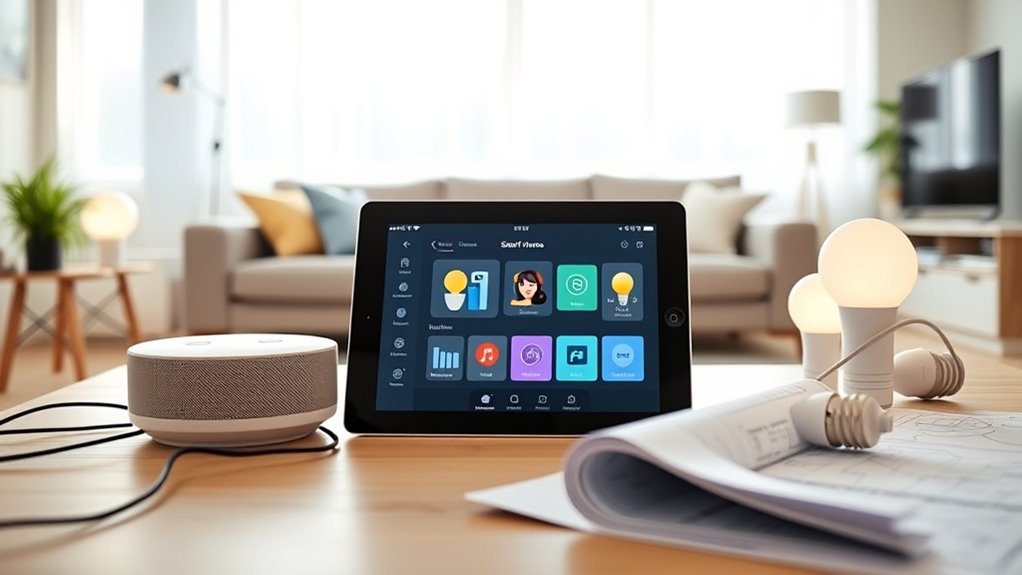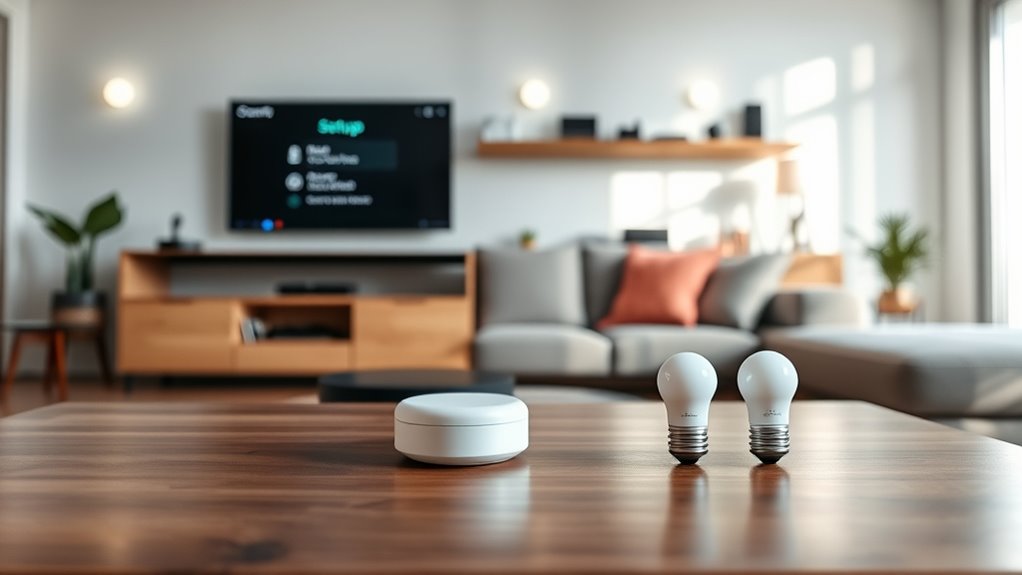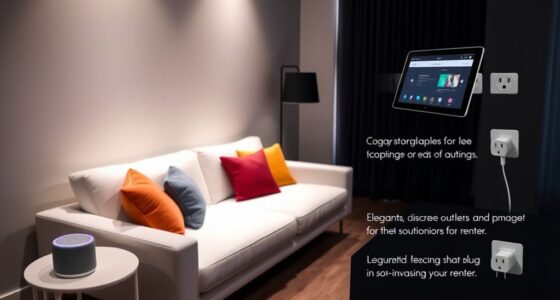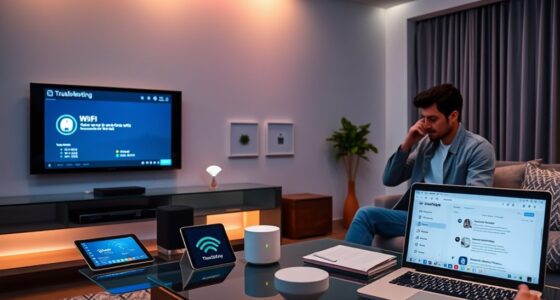To plan your first smart home setup, start by choosing compatible devices that work with your preferred platform or hub. Set a clear budget to prioritize essential items like smart bulbs or thermostats, and think about your daily routines and home layout to select devices that fit your lifestyle. Doing thorough research and reading reviews helps avoid issues later. Keep planning to make certain of a smooth, seamless installation—your ideal smart home awaits as you learn more.
Key Takeaways
- Determine your primary goals, such as security, lighting, or climate control, to guide device selection.
- Assess your home layout and routines to identify the most useful devices and optimal placement.
- Research device compatibility with your preferred hub or app to ensure seamless integration.
- Set a realistic budget, prioritizing essential devices and considering ongoing costs like subscriptions.
- Plan installation steps, choosing compatible devices to simplify setup and minimize troubleshooting.

Are you ready to transform your living space into a smart home? The first step is planning carefully so your setup is seamless and meets your needs. Start by considering the devices you want to include. Device compatibility is key here—different smart gadgets operate on various platforms and protocols. For example, some devices use Wi-Fi, while others rely on Zigbee or Z-Wave. Ensuring your chosen devices can communicate within a single ecosystem will save you headaches later. Check compatibility with your preferred smart home hub or app, and avoid mixing incompatible systems that could complicate your setup or limit functionality. This upfront research helps prevent frustration and guarantees your smart home operates smoothly.
Start by choosing compatible devices that operate on the same platform to ensure seamless smart home integration.
Next, think about your budget considerations. Smart home technology can range from affordable to high-end, so it’s important to set a clear budget before you start shopping. Decide how much you’re willing to spend overall, then prioritize the devices that will deliver the most value or convenience for you. For instance, investing in a good smart speaker or hub can serve as the central control point for multiple devices, making your setup more efficient and user-friendly. You don’t have to buy everything at once—start small with a few essential devices, such as smart bulbs or a smart thermostat, and expand over time as your budget allows. Keep in mind that some smart devices have ongoing costs, like subscription services for advanced features, so factor those into your budget as well.
As you plan, think about your daily routines and what you want your smart home to achieve. Do you want to automate lighting for convenience? Or maybe you’re looking to enhance security with cameras and doorbells? Clarifying your goals will help you select the right devices and avoid impulse purchases that may not fit your needs. Also, consider the layout of your home—larger spaces might require more hubs or Wi-Fi extenders to ensure reliable connectivity for all devices. Additionally, understanding the importance of device compatibility can help you select products that work seamlessly together, reducing setup issues and improving overall user experience.
Finally, make sure to read reviews and do a bit of research on brands known for quality and compatibility. This will help you avoid devices that are prone to issues or don’t play well with others. Planning your smart home setup with careful attention to device compatibility and budget considerations ensures a smoother installation process and a more satisfying experience. Once you’ve done your homework, you’ll be ready to start building a connected, efficient, and personalized smart home that fits your lifestyle perfectly.
Frequently Asked Questions
What Is the Best Budget for Initial Smart Home Devices?
When determining your budget for initial smart home devices, consider your budget considerations to avoid overspending. Start with essential device selection, like smart bulbs or a smart speaker, which are affordable and versatile. Setting a clear budget helps you prioritize devices that deliver the most value. Keep in mind that you don’t need the most expensive gadgets; affordable options can still enhance your smart home experience without breaking the bank.
How Secure Is My Data With Smart Home Devices?
Your data with smart home devices is like a fragile glass; privacy concerns are real, but good security measures help protect it. Manufacturers often use data encryption to keep your information safe from hackers and unauthorized access. While no system is completely foolproof, you can enhance security by regularly updating devices, using strong passwords, and choosing reputable brands. This way, your smart home stays secure and your privacy stays intact.
Can I Control My Smart Home Remotely?
Yes, you can control your smart home remotely through secure apps or web portals. Many devices offer remote access features, allowing you to manage your home from anywhere. However, be aware of security concerns—ensure you use strong passwords and enable two-factor authentication to protect your data. Regularly update firmware and stay vigilant to prevent unauthorized access, keeping your remote control safe and reliable.
Which Smart Home Platforms Are Most Compatible?
Of course, you want your smart home to play nice with everything, right? Luckily, platforms like Amazon Alexa, Google Assistant, and Apple HomeKit dominate the scene, thanks to their broad voice assistant integrations and strict device compatibility standards. Just remember, choosing a platform with solid voice assistant integrations guarantees your devices chat smoothly. Stick with these giants, and you’ll avoid the chaos of incompatible gadgets turning your home into a tech jungle.
How Do I Troubleshoot Common Smart Home Device Issues?
When troubleshooting common smart home device issues, start by checking the device firmware to make certain it’s up to date. If you experience Wi-Fi connectivity problems, try restarting your router and moving the device closer to the Wi-Fi source. Also, reconfigure the device’s network settings if needed. Regularly updating firmware and maintaining a strong Wi-Fi connection help keep your smart devices running smoothly and reduce issues.
Conclusion
Now that you’ve got the essentials down, you’re ready to turn your home into a futuristic haven! Remember, planning wisely means your smart home will run smoother than a rocket soaring through the stars. Don’t rush—enjoy the process and explore new gadgets that excite you. With a little patience and curiosity, you’ll create a space so intelligent and efficient, it’ll feel like living in the future today. Your dream smart home is just a smart step away!
Alfons is the visionary leader and driving force behind Voyager Info’s success. As the Editor in Chief, he brings a wealth of experience and an unwavering passion for travel to the helm of our cruise-centric platform.
With a lifelong fascination for exploring new horizons, Alfons discovered his love for the ocean and cruising at a young age. From sailing across pristine Caribbean waters to embarking on daring expeditions to far-flung destinations, he has amassed a treasure trove of first-hand experiences in the world of cruising.











